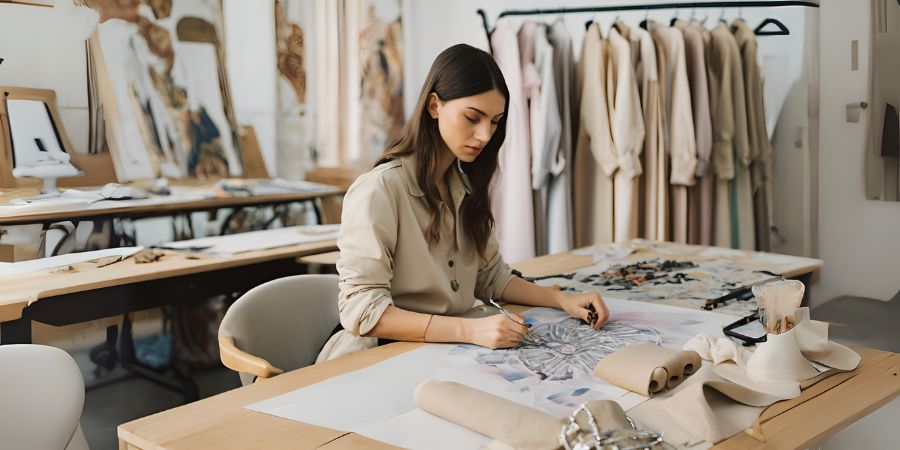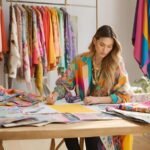Fashion design is a captivating profession that blends creativity, technical skill, and an understanding of cultural trends to create wearable art. The work setting for a fashion designer can vary significantly depending on their role, employer, and personal career choices. From high-energy studios to the quieter realms of freelance design, the environment shapes how designers conceptualize, create, and bring their visions to life.
The Typical Work Environments for Fashion Designers
Fashion designers work in diverse environments, each offering unique challenges and rewards. Let’s explore the most common settings:
1. Design Studios
Design studios are one of the most iconic workspaces for fashion designers. These studios often house small teams of designers, pattern makers, and seamstresses collaborating on collections.
Key Features of Design Studios:
- Creative Space: Equipped with sewing machines, fabric swatches, sketching tools, and mood boards.
- Teamwork: Designers often work closely with other creatives to finalize designs.
- High Energy: Deadlines for fashion shows or client demands can create a dynamic and fast-paced atmosphere.
2. Corporate Offices
In larger fashion houses or retail companies, fashion designers often work in corporate offices. Here, they collaborate with marketing, production, and sales teams to create market-ready products.
Corporate Setting Highlights:
- Structured Workflow: Designers follow a clear design process, from initial sketches to product development.
- Technology Integration: Computer-aided design (CAD) software is commonly used for creating digital prototypes.
- Market-Driven Designs: Designers align their work with consumer trends and brand identity.
3. Manufacturing Units and Factories
Fashion designers often visit manufacturing facilities to oversee production. This is crucial for ensuring that the designs are executed accurately.
What Happens Here:
- Quality Control: Designers verify the quality of fabrics, stitching, and construction.
- Prototype Testing: Initial designs are tested for wearability and durability.
- Mass Production Coordination: Designers liaise with production managers to ensure scalability without compromising quality.
4. Freelance or Home-Based Workspaces
Many fashion designers opt for freelance careers, working from home or shared coworking spaces. This setup provides flexibility and independence.
Advantages of Freelance Design:
- Autonomy: Freedom to choose projects and clients.
- Custom Workspaces: Designers can create personalized environments tailored to their needs.
- Remote Collaboration: With digital tools, designers can work with clients and manufacturers globally.
5. Fashion Shows and Events
While not a daily workspace, fashion shows and events are vital for showcasing a designer’s work.
Key Activities:
- Event Planning: Collaborating with event coordinators to organize runway shows.
- On-Site Adjustments: Last-minute tweaks to outfits for models.
- Networking: Building connections with industry professionals, buyers, and media.
Tools and Technologies in Fashion Design Workspaces
Fashion design work settings are equipped with various tools and technologies that streamline the creative process. Here are the essentials:
1. Traditional Tools
- Sketching Supplies: Pencils, markers, and sketchbooks for initial designs.
- Mannequins: Essential for draping and visualizing garment structures.
- Sewing Machines: Ranging from basic to industrial models for prototyping.
2. Digital Tools
- CAD Software: Programs like Adobe Illustrator or CLO 3D for creating virtual designs.
- Fabric Design Tools: Software for designing custom prints and patterns.
- Project Management Tools: Platforms like Trello or Slack for coordinating team efforts.
3. Emerging Technologies
- 3D Printing: Used for creating innovative designs and accessories.
- AI and Machine Learning: Analyzing fashion trends and consumer preferences.
- Augmented Reality (AR): Helping designers visualize how garments will look and fit.
The Work Culture in Fashion Design
The culture of a fashion design workspace is often shaped by creativity, collaboration, and tight deadlines. Here’s what to expect:
1. Creativity and Innovation: Fashion design thrives on innovation. Designers are encouraged to push boundaries and explore unconventional ideas.
2. Collaboration: Designers often collaborate with pattern makers, textile experts, and marketers. Open communication and teamwork are essential.
3. Fast-Paced Environment: The fashion industry operates on tight schedules, with designers frequently juggling multiple projects and deadlines.
Challenges of Fashion Design Work Settings
While rewarding, the fashion design profession comes with its share of challenges:
1. Pressure to Innovate: The demand for fresh and unique designs can be mentally taxing.
2. Time Constraints: Deadlines for collections, events, or client deliveries can lead to long working hours.
3. Physical Demands: Tasks like sewing, draping, or managing photo shoots can be physically exhausting.
4. High Competition: The fashion industry is highly competitive, requiring designers to consistently prove their worth.
Tips for Thriving in a Fashion Design Work Setting
To succeed in this dynamic field, consider these tips:
1. Organize Your Workspace: A clutter-free and inspiring environment boosts creativity and efficiency.
2. Invest in Tools: High-quality tools and technology can significantly enhance your productivity.
3. Stay Updated on Trends: Regularly research fashion trends to stay ahead in the industry.
4. Build a Network: Strong industry connections can open doors to collaborations and career growth.
5. Prioritize Self-Care: Balancing work and personal life is crucial for maintaining long-term passion and creativity.
FAQs
What is the work environment of a designer?
Designers typically work in creative and collaborative environments like design studios, corporate offices, or home-based workspaces. Their work often involves using specialized tools, both traditional and digital, and may require teamwork and problem-solving under deadlines.
What is the work environment for a fashion stylist?
Fashion stylists work in dynamic environments, including photo studios, retail spaces, or on-location for shoots and events. Their work often requires travel, coordination with photographers, models, and designers, and adaptability to various settings.
What is the work of fashion?
Fashion work involves designing, creating, and styling clothing, accessories, or footwear that align with cultural trends and consumer needs. It includes research, sketching, material selection, and production, as well as showcasing designs in shows or marketing campaigns.
Do fashion designers work indoors or outdoors?
Fashion designers primarily work indoors in studios, corporate offices, or manufacturing units. However, they may occasionally work outdoors during fashion events, photo shoots, or while sourcing materials.
What setting do fashion designers work in?
Fashion designers work in diverse settings, such as design studios, corporate offices, manufacturing units, home-based spaces, or on-site at fashion shows and events.
Do fashion designers work from home?
Yes, many fashion designers, especially freelancers, work from home. They use home-based workspaces for designing, collaborating digitally, and managing projects remotely.
Conclusion
The work setting for a fashion designer is as dynamic and varied as the industry itself. Whether in a bustling studio, a corporate office, or the comfort of a home-based workspace, each environment plays a crucial role in shaping a designer’s creative journey. Understanding these settings, leveraging the right tools, and embracing the industry’s collaborative culture can pave the way for a fulfilling and successful career in fashion design.


